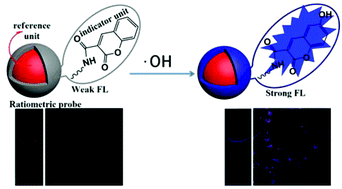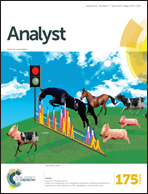Dual-emissive fluorescence measurements of hydroxyl radicals using a coumarin-activated silica nanohybrid probe†
Abstract
This work reports a novel dual-emissive fluorescent probe based on dye hybrid silica nanoparticles for ratiometric measurement of the hydroxyl radical (˙OH). In the probe sensing system, the blue emission of coumarin dye (coumarin-3-carboxylic acid, CCA) immobilized on the nanoparticle surface is selectively enhanced by ˙OH due to the formation of a coumarin hydroxylation product with strong fluorescence, whereas the emission of red fluorescent dye encapsulated in the silica nanoparticle is insensitive to ˙OH as a self-referencing signal, and so the probe provides a good quantitative analysis based on ratiometric fluorescence measurement with a detection limit of 1.65 μM. Moreover, the probe also shows high selectivity for ˙OH determination against metal ions, other reactive oxygen species and biological species. More importantly, it exhibits low cytotoxicity and high biocompatibility in living cells, and has been successfully used for cellular imaging of ˙OH, showing its promising application for monitoring of intracellular ˙OH signaling events.


 Please wait while we load your content...
Please wait while we load your content...